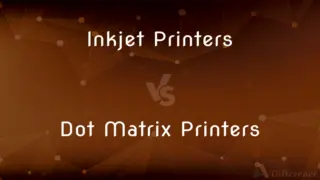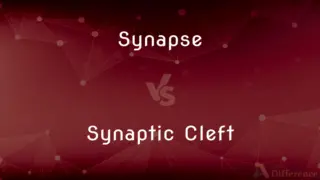Inequalities vs. Equations — What's the Difference?
Edited by Tayyaba Rehman — By Fiza Rafique — Published on December 9, 2023
Inequalities express a relationship indicating one value is greater or less than another. Equations assert two expressions are equal, meaning they have the same value.

Difference Between Inequalities and Equations
Table of Contents
ADVERTISEMENT
Key Differences
Inequalities represent mathematical statements that two quantities are not necessarily equal. Equations, on the other hand, are mathematical expressions indicating two quantities are precisely equal.
Inequalities can use symbols like <, >, ≤, or ≥ to depict the relationship between two expressions. Equations exclusively use the = symbol to showcase that the expressions on either side have the same value.
When solving Inequalities, the goal is often to determine a range of possible values. With Equations, the objective is to pinpoint a specific value or values that satisfy the equality.
In real-life applications, Inequalities might be used to represent conditions with an upper or lower limit, like budget constraints. Equations can depict exact relationships, such as the formula for calculating the area of a rectangle.
While both Inequalities and Equations play a vital role in mathematics, they serve different purposes: Inequalities suggest a range or disparity, while Equations establish definitive equivalency.
ADVERTISEMENT
Comparison Chart
Definition
Relationship showing disparity between values.
Relationship asserting equality of expressions.
Symbols Used
<, >, ≤, ≥
=
Solution
Range of values
Specific value(s)
Real-life Application
Budget constraints, speed limits
Area formulas, balance sheets
Purpose
Indicate greater, less, or range relationship.
Establish exact equivalency.
Compare with Definitions
Inequalities
Expressions showing one quantity is larger or smaller than another.
The stock's value is ≥ $50 uses Inequalities to depict a minimum stock value.
Equations
Expressions indicating equivalency between quantities.
E = mc^2 is among the famous Equations in physics.
Inequalities
Tools in math to depict non-equivalence relationships.
The speed of a car < 60 mph uses Inequalities to show a speed limit.
Equations
Tools in math to depict exact relationships.
Y = mx + b is the Equation of a line in slope-intercept form.
Inequalities
Mathematical statements indicating disparity between two expressions.
In the context of Inequalities, x > 5 means x is greater than 5.
Equations
Relations used to establish a definite relationship between quantities.
The formula A = πr^2 is an Equation for the area of a circle.
Inequalities
Relations used to establish bounds or limits on quantities.
In financial planning, Inequalities can set an upper limit on expenses.
Equations
Mathematical statements asserting two expressions are equal.
2 + 2 = 4 is one of the basic Equations we learn in math.
Inequalities
The condition of being unequal.
Equations
The act or process of equating or of being equated.
Inequalities
An instance of being unequal.
Equations
The state of being equal.
Inequalities
Lack of equality, as of opportunity, treatment, or status.
Equations
(Mathematics) A statement asserting the equality of two expressions, usually written as a linear array of symbols that are separated into left and right sides and joined by an equal sign.
Inequalities
Social or economic disparity
The growing inequality between rich and poor.
Equations
(Chemistry) A representation of a chemical reaction, usually written as a linear array in which the symbols and quantities of the reactants are separated from those of the products by an arrow or a set of opposing arrows.
Inequalities
Lack of smoothness or regularity; unevenness.
Equations
A complex of variable elements or factors
"The world was full of equations ... there must be an answer for everything, if only you knew how to set forth the questions" (Anne Tyler).
Inequalities
Variability; changeability.
Equations
Plural of equation
Inequalities
(Mathematics) An algebraic relation showing that a quantity is greater than or less than another quantity.
Equations
Mathematical formulations showcasing an equality relationship.
Force = Mass x Acceleration is an Equation from Newton's second law.
Inequalities
(Astronomy) A deviation from uniformity in the apparent motion of a celestial body.
Inequalities
Plural of inequality
Inequalities
Representations not asserting exact equality between values.
Saying The number of attendees ≤ 100 uses Inequalities to show a potential range.
Common Curiosities
Can Equations have no solution?
Yes, some Equations might have no real solution, depending on their structure.
Can Equations have multiple solutions?
Yes, some Equations, especially quadratic ones, can have more than one solution.
Do Inequalities always have a solution?
Not always. Some Inequalities might not have a solution within a given domain.
What's the main difference between Inequalities and Equations?
Inequalities show disparity between values, while Equations assert exact equality.
Are Inequalities only used in mathematics?
No, Inequalities have applications in economics, physics, and various fields to denote ranges or limits.
Are all mathematical relations either Inequalities or Equations?
No, while many are Inequalities or Equations, there are other mathematical relations like identities or congruences.
Can Inequalities establish exact values?
Inequalities generally depict ranges or limits, not exact values.
Which symbol represents "greater than or equal to" in Inequalities?
The symbol "≥" represents "greater than or equal to" in Inequalities.
Can Equations represent physical laws?
Yes, many physical laws, like Newton's laws, are represented as Equations.
Do Equations always involve numbers?
No, Equations can involve variables, constants, and even functions without specific numbers.
Which symbol is exclusively associated with Equations?
The "=" symbol is exclusively associated with Equations.
Can Inequalities be combined in a system?
Yes, you can have a system of Inequalities, often used in optimization problems.
Are all Equations linear?
No, Equations can be linear, quadratic, cubic, or of even higher orders.
Are Inequalities always strict?
No, Inequalities can be strict (like < or >) or non-strict (like ≤ or ≥).
Are there graphical methods to solve both Inequalities and Equations?
Yes, both Inequalities and Equations can be represented and solved graphically, often using coordinate planes.
Share Your Discovery

Previous Comparison
Inkjet Printers vs. Dot Matrix Printers
Next Comparison
Synapse vs. Synaptic CleftAuthor Spotlight
Written by
Fiza RafiqueFiza Rafique is a skilled content writer at AskDifference.com, where she meticulously refines and enhances written pieces. Drawing from her vast editorial expertise, Fiza ensures clarity, accuracy, and precision in every article. Passionate about language, she continually seeks to elevate the quality of content for readers worldwide.
Edited by
Tayyaba RehmanTayyaba Rehman is a distinguished writer, currently serving as a primary contributor to askdifference.com. As a researcher in semantics and etymology, Tayyaba's passion for the complexity of languages and their distinctions has found a perfect home on the platform. Tayyaba delves into the intricacies of language, distinguishing between commonly confused words and phrases, thereby providing clarity for readers worldwide.












































